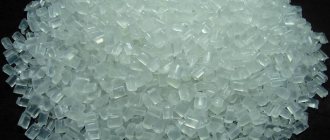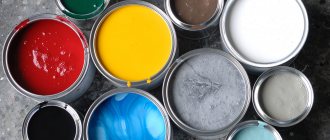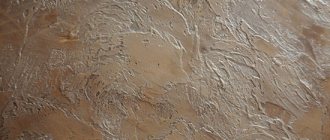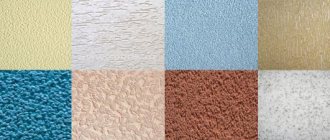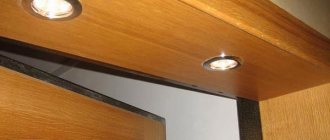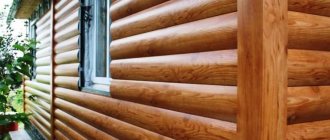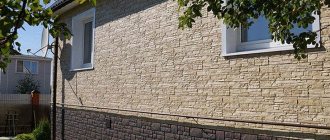Application of white spirit
Before diluting PF-115 enamels with white spirit, you need to think about safety measures.
It is necessary to protect the skin of your hands with gloves. The room must have good ventilation. Many believe that in order to avoid negative effects on the human body, it is better to carry out work outdoors. But, in this case, the result will not always be pleasing. Under such conditions, layer uniformity will be difficult to achieve. For a high-quality result, it is better to prepare a suitable room.
Let's consider the main factors of the negative impact of white spirit vapor on the human body:
- An increased concentration of white spirit vapor in a room will cause headaches and irritation of the eyeball.
- Inhalation of vapors may cause pulmonary edema or bronchopneumonia.
- An increased concentration of vapors can cause them to enter the stomach. Even if you do timely washing, the vapors will disappear only after 4 - 5 days.
White spirit vapors are very dangerous to human health. Take all precautions when working with it.
So, the use of PF-115 paint, how it can be diluted, is up to consumers to decide. The main thing is to use the diluent correctly. By adding the composition in accordance with the PF 115 enamel, we avoid all troubles and exclude the possibility of any defects.
Difference in solvents (1 video)
Different types of solvents (25 photos)
How to dilute?
PF or GF enamels are sold ready for application and with the degree of thickness that best matches the composition of the material. However, if the composition needs to be diluted, it is necessary to add only the minimum amount of diluent, for example:
- If external painting is necessary, then the finished paint should be diluted by adding a thinner in an amount of no more than 3% of the total volume of enamel.
- For interior work, the finished paint should be diluted with a thinner amount of no more than 5% of the total volume.
- If you dilute the composition with a large amount of thinner, the enamel flows down (in particular, from vertical planes) and forms streaks. In addition, the performance characteristics of the paintwork are reduced.
It should be noted that the material composition and percentage of ingredients in painting materials is not accidental and is the result of many years of experience . Therefore, the desire to improve the quality of a painted surface by adding a thinner in an arbitrary amount often leads to a deterioration in the characteristics of the coating.
Don’t delude yourself and look for a universal solvent. There is no such thing. For each type of dye, there are corresponding solvents. How to figure this out? The main rule to remember is that the bases of the coloring matter and the solvent must be the same.
Solvents are mainly divided into the following types:
- Petroleum based (gasoline, solvent, white spirit, orthoxyrol). Most often they are used to dissolve oil-based paints and varnishes.
- Contains organic components (acetone, xylene). The most common types of solvents, as they rarely disturb the structure of the coloring matter.
- With chemical additives. Solvents of this type are divided by marking: P-4, 646, 647, 650.
It should be borne in mind that the higher the number in the marking, the higher the degree of fat content, which means that the paint will take much longer to dry.
Types of floor enamels and technical characteristics
Enamel contains various substances, including varnishes and color pigments. These components determine on what basis the coating will be produced, organic or water-based. Paintwork materials also differ in structure:
- Hammer;
- Primer;
- Acrylic;
- Polyurethane;
- Alkyd.
Let's look at the main types of floor paints used when painting flooring.
Alkyd
Alkyd enamel used for flooring is very durable and protects well from moisture and ultraviolet rays. Based on resins and vegetable oils. Divided into 2 types of coatings:
Alkyd-urethane
Alkyd-urethane floor enamel is used to coat wooden surfaces, as well as chipboard and fiberboard. This paint protects the floor well from mechanical damage and does not wear off when exposed to detergents; it is a quick-drying composition.
Mode of application
When thinning the paint, the thinner should be added in small portions, while mixing well. This helps to get the right consistency. The optimal amount of solvent should be 15% of the total volume, otherwise resin may fall out and damage the material. Strongly thickened enamel is first diluted, mixed, left for 3-4 hours, and then brought to the desired consistency with a thinner.
Almost all solvents are flammable, so they should be stored in a closed container, out of the reach of children. Opening containers with such liquids is permitted only with tools that do not produce sparks upon impact.
When working with thinners, you must remember to take precautions: wear a protective respiratory mask and gloves, since even a small contact of substances with the skin can cause irritation. If the liquid does get on open areas of the skin, they must be washed with warm water and soap, and if it gets on the mucous membrane or in the eyes, then you need to promptly consult a doctor.
If these liquids ignite during operation, it is necessary to use special fire extinguishing agents: air-mechanical or chemical foam from fire extinguishers. Water is useless in this case.
In the room where you work with diluents, it is necessary to ensure good ventilation so that their vapors do not cause dizziness. If you use auto enamel in a garage, you must turn on the ventilation or open the doors and windows.
All solvents have a certain hazard class, for example, for 646 it is class 3, which must be recorded in the product passport.
It should be noted that a high-quality diluent should not leave white or dull spots during operation; it does not freeze or become viscous.
Many, if not most, home craftsmen are familiar with this situation: they opened a can, and the paint in it was thickened. It doesn’t matter - it can always be dissolved.
Basic rules for diluting paints
The most important rule is that like dissolves like. Agree, it is stupid to use acetone to dilute oil paint and expect that the dissolved paint will be of a uniform consistency and without curdled clumps.
Therefore, first of all, carefully study the label on the can of paint and understand its composition. At worst, at least find out the type of paint in the can.
Start thinning the paint with a small test amount. Having placed just a little bit of thickened paint in a small bowl, add a little bit to it and if, after thorough mixing, it acquires the necessary viscosity without losing its properties, you can safely begin to dissolve the main volume of paint.
Be careful with the amount of thinner, add it to the paint in small portions.
Remember: you can almost always make liquid paint from thick paint, but it is very difficult to make thick paint from liquid paint.
After thinning the paint, before starting painting work, get rid of debris and undissolved elements by straining it through a sieve or layer of gauze.
Water-dispersion paints
As the name suggests, these paints consist of water, pigment and a binder.
Among the family of water-dispersion paints, consisting of gouache, watercolor and acrylic, the latter is the most popular and in demand, because after drying it is not afraid of water and precipitation.
Acrylic paints are environmentally friendly, they are suitable for both interior and exterior finishing work.
Despite the fact that special chemical compositions for dissolving water-dispersion paints have recently appeared on the building materials market, the main means for diluting water-based paints is clean cold water.
Oil paints
Widespread due to its moderate cost. Ideal for (walls, roofs, etc.) due to the fact that they form a protective layer that prevents moisture penetration.
In the production of oil paints, a dye and various types of essential oils are used.
It is for this reason that when diluting thickened oil paint, it is advisable to use drying oil, oil-resin varnish or white spirit.
Enamels
The family of enamels is represented by perhaps the widest range among other types of paints. Depending on the brand of paint, a specific type of solvent will be required.
Enamels PF-253 and PF-266 can be diluted with both turpentine and. To dilute the paints PF-115, GF-230, PF-1126 you will need white spirit or turpentine.
It is better to dilute “Extra” brand enamels with a solvent, although the already mentioned turpentine or white spirit can be used. KO-112 and KO-168 are excellently diluted with solvents R-4, R-6 or No. 646, and enamels PF-133 and PF-223 with xylene. To thin NTs-132 paint you will need solvents No. 645 or No. 646.
Despite the apparent strict connection of enamels to certain types of thinners, most solvents are interchangeable. So don't be afraid - experiment, mix and paint.
Good luck to you! May everything work out for you!
If you decide to paint your car with PF 115 paint, be patient and take several tools. Remember that you should not apply the substance to the surface without thoroughly preparing it. In addition, when you open the can, you may find that the paint is too thick - then you will have to thin it. The choice of solvent must be taken very carefully - the wrong thinner can not only not bring any results, but also ruin the paint.
Characteristics and Features
The main features of soils based on alkyd components include the following:
- Excellent resistance to temperature conditions;
- Reducing the consumption of materials used for surface finishing;
- Increasing resistance to abrasion, wear and chemical elements;
- Absolute surface protection from fungus, mold, rust and swelling;
- Eliminates the risk of resin protruding from the wood surface.
It should be noted that soil characteristics are often based on composition. That is why the following types of alkyd mixtures should be distinguished, taking into account the types of composition:
- Glypthal soils. They differ from other representatives in that the mixture includes a dye and a special filler, with which you can increase the efficiency of external and internal work;
- Perchlorovinyl mixtures - used in working with concrete, metal and plaster. They have a high degree of drying, but are mixtures with a high level of toxicity. That is why they are used in outdoor work using safety measures;
- Polyvinyl acetate mixtures are used before exterior finishing based on alkyd components. They have the most favorable drying time - 30 minutes;
- Alkyd-acrylic compositions are characterized by deep penetration into the material. This type of primer is considered a universal processing tool and is successfully used in working with wood and metal.
Despite the great difference in the characteristics of the components that may be included in alkyd primers, the surface treatment product always has excellent characteristics. The main thing is to follow the instructions and take advantage of safety measures.
Selection of alkyd enamel based on solvent composition
For each specific case, you can choose alkyd enamel and make the surface not only beautiful, but also protect it from external influences and rapid destruction. Some of the paints are designed for treating wooden surfaces, while others are for painting metal.
Alkyd auto enamel is used directly for painting a car, that is, it is already prepared for applying varnish of a certain tone to a metal surface. Alkyd car enamel can withstand any temperature in unpredictable weather, both in summer and winter. At the same time, the painted surface is comparable in gloss to acrylic painting.
The big disadvantage of alkyd auto enamel is that it takes a long time to dry, despite the fact that it contains a solvent. For complete and quick drying, sometimes special installations are even purchased if painting is done at a professional level, which entails additional financial costs.
Processing wooden surfaces and drying them is much faster. The solvent is well absorbed into the material and evaporates into the atmosphere in a short time, protecting it from moisture or spillage.
Solvents, like alkyd enamels, in this case must be selected according to their properties and characteristics, as far as safety for the human body, since not everything can be used for painting, for example, pieces of furniture in the house.
Solvents for alkyd enamel come in a wide variety, but in order to choose the most suitable one, it is better to be supervised by its characteristics. You can add solvents to alkyd enamel yourself or buy paint that contains the desired solvent.
While renovating the garage, we found alkyd enamel, but it had hardened. How can I dilute old alkyd enamel so that it can be used?
This may be useless, it all depends on the degree of hardening, it is even possible that you simply cannot dilute it and will waste your money. By the way, diluted enamel will no longer have such good properties and is best used in places where there is no need to obtain quality work.
Read more: Niva injector idle speed floats
So, if you have decided, then first we look at the brand of alkyd enamel and, accordingly, based on the brand, we use the thinner that is most likely suitable for your paint.
Turpentine – GF-230, PF-115, PF-253, PF-266.
White spirit - GF-230, PF-115, PF-1126.
Xylenes – PF-133, PF-223.
Solvent (can be used with gasoline) – PF-133, PF-223.
Solvent No. 646, R 4 or R 6 – PF-253, PF-266, KO-168, KO-112.
It is necessary to remember that no solvent can quickly dissolve paint (if at all), so pour the solvent into a jar and from time to time just stir the jar without opening it, and so on for a day or two, preferably 0.5 hours at a time.
Then shake the jar well and leave for another day. After this, stir all the paint. that has dissolved and pass through a filter, you can use gauze.
Yes, a hackneyed phrase that I have already cited in many answers
But in order to use it correctly, you need to know exactly what you want to dissolve and with what solvent.
It is known that alkyd paints contain alkyd resins. In turn, alkyd resins contain aromatic components. For those who have not studied chemistry well or have forgotten, let me remind you that aromatic compounds are benzene derivatives.
So the solvents must also be aromatic derivatives.
So, although there is information on the Internet that the best solvent for dissolving alkyd paints is white spirit or nefras, or solvent, which is actually the same thing, namely a mixture of aliphatic liquids of hexane and heptane.
So such solvents are not the best choice, but it is better to use toluene, but it is used in factories and you will not find it on sale, so xylene, which is a homologous analogue of toluene, but less harmful and slightly weaker in dissolving power, is suitable.
Thinning alkyd paint is a necessary procedure when carrying out painting work.
In some cases, how and with what you dilute alkyd paint will have a decisive influence on the quality of the paint.
For automotive enamels, it is also often necessary to thin the paint to achieve the desired consistency, but this is required less frequently.
Let's look at how to dilute alkyd paint below.
Types of solvents
White spirit - produced during the distillation of petroleum products, is an excretory element of one of the fractions. This type of solvent is considered the most harmless due to the fact that its odor is not as strong as that of other types of solvents. White spirit is often used for:
- paint thinning;
- elimination of viscous enamel defect;
- removing oily stains from the surface before applying paint;
- washing brushes;
- accelerating the drying process of oil-based paints;
- painting wooden material as protection against bark beetles and moisture.
The time required for complete drying will be longer than for turpentine-based paints, but less than for solvent-based paints.
- Turpentine is a solvent that has long been familiar to us, obtained during the process of distilling resins from coniferous wood and is mainly used as a thinner to clean surfaces from oily stains. It can be easily recognized among other thinners by its sharp and unpleasant odor. This degreaser has a certain peculiarity: turpentine-based paints take a long time to dry, but in some cases this is even necessary. With a high quality of evaporation, turpentine does not cause irritation or other phenomena when a small amount of the product gets on the skin, but in case of fire safety, it can easily ignite.
- Solvent is used in cases where it is necessary to achieve rapid drying of surfaces due to the immediate evaporation of vapors from the alkyd applied substance. In order to prevent a fire in the room, it is better to store containers containing solvents in the open air or in a well-ventilated area. It is good to treat the surface with solvent to remove traces of oil and wax.
- Xylene. It belongs to the group of highly volatile substances and has a high dissolving ability, evaporates quickly and leaves no odor. It can be used both to obtain the required viscosity of the paint and varnish composition, for this purpose the solvent is added in small portions and mixed, and to remove alkyd paint from surfaces. Xylene R-646 has an irritating effect on the skin and mucous membranes. Therefore, all work with it indoors must be carried out in compliance with safety regulations and the use of personal protective equipment: rubber gloves and a respirator. In case of contact with skin, the solvent must be washed off with warm water and soap.
Read more: How to convert a 406 injector to a carburetor
How to dilute alkyd paint: choose a solvent
Painting work involves a variety of execution techniques, as well as the use of various devices, equipment and paints and varnishes. Before starting painting work, you need to rationally choose the color scheme for the room. To carry out both indoor and outdoor work, certain types of paints, varnishes, putties, etc. have been created, which, depending on operating conditions, differ in components and characteristics. A significant segment of the paint and varnish market is occupied by alkyd paints and enamels, which have a number of useful properties.
What's in it?
The composition of alkyd painting materials largely determines the properties and characteristics of varnishes, paints and primers. In general, any paint and varnish material contains ingredients such as:
- coloring pigments;
- various excipients;
- thinners;
- driers – substances that accelerate drying, etc.
As for alkyd paints, they contain alkyd polymers (resins) as foaming agents. But depending on the type of resin, pentaphthalic and glyphthalic binders are distinguished, and, accordingly, pentaphthalic (marking - PF) or glyphthalic (GF) enamels, primers and varnishes are produced. In addition, on alkyd drying oil, in addition to traditional liquid ones, thickly grated compositions are also produced (GF-013, PF-014, etc.). Enamel painting material, or simply enamel, is a paint with which you can obtain not a matte, but a glossy or even mirror-like surface.
The segment of alkyd materials includes paints having the following base:
- drying oil (marking - MA);
- glyphthalic and pentaphthalic varnishes (marking - GF and PF);
- oil-phenolic varnish (marked FA).
These types of coloring compounds can be mixed with each other. In addition, to dilute or dissolve them, the same solvents and thinners are used, but when preparing the working surface for application, identical primers and putties are used.
As for the methods of working with such compositions, as a rule, all pentaphthalic and glypthalic enamels are applied in two layers using a roller or brush. With this method of application, the material consumption will be, on average, 150g/m2. Complete drying of PF or GF paint occurs after 24-36 hours (similar to oil paints).
Types of coloring materials
This is the main factor that determines which paint thinner you can use.
Acrylic enamel
Consists of several components. Before painting, mix with hardener and dilute with thinner to the desired consistency. Suitable solvents for diluting it:
- R-12;
- 650 (soft enough, so suitable for many coloring agents);
- 651.
The content of the diluent should not exceed 10-15% of the volume. The exact consumption must be clarified when purchasing from a specialist.
Alkyd enamel
A universal material, it is used not only for painting surfaces made of various materials, but also used as an anti-rust primer.
- toluene;
- xylene;
- P4;
- white spirit (it is better to use artistic white spirit, since regular white spirit may contain impurities that precipitate).
Nitro enamels
Any type of solvent is suitable for this paint option, but it is better to use the one recommended by the manufacturer. When diluting nitro enamels, you can use 646 (it is also suitable for primer), however, please note that this is a very aggressive type of diluent and must be used carefully.
Water-based paint
The water-based emulsion can be diluted with water, alcohol or ether. It is important to remember that the water must be distilled, since ordinary water, even fresh water, contains a large amount of salt impurities, which can cause a white coating when the coating dries. Alcohol may not be compatible with the dye, so it is necessary to test on a small amount before diluting the entire volume; if the paint being tested does not curdle after dilution with alcohol, then the substances are compatible and this thinner can be used.
If, when you add alcohol to the paint, it curls, then this paint is not suitable for thinning with alcohol.
Filler
The filler is a primer; the preparatory material is no less important to dilute correctly than the coating that is supposed to follow it. The main task of the primer is to smooth out micro-irregularities of the surface before painting, which is not only necessary when painting, but also protects against rust in the future.
If the primer film is too thin, it will not be able to cover all defects and depressions and will have to be reapplied, which leads to additional costs. If the soil is too thick, its penetrating and rust-protecting ability will be reduced and it will again not be able to fill uneven surfaces. The material will begin to peel off and will not be able to spread, resulting in the formation of shagreen, which will have to be removed by sanding.
